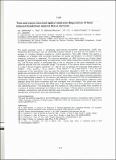Por favor, use este identificador para citar o enlazar a este item:
http://hdl.handle.net/10261/110766COMPARTIR / EXPORTAR:
 SHARE
BASE SHARE
BASE
|
|
| Visualizar otros formatos: MARC | Dublin Core | RDF | ORE | MODS | METS | DIDL | DATACITE | |

| Título: | Time and space resolved optical emission diagnostics of laser induced breakdown muscle tissue samples |
Autor: | Camacho, J.J.; Díaz Sol, Luis CSIC ORCID; Martínez-Ramírez, S. CSIC ORCID ; Cid, J.P.; Marín-Roldán, A.; Moncayo, S.; Cáceres, J.O. | Fecha de publicación: | 9-jul-2014 | Editor: | Universidad de La Rioja | Citación: | XXIV RNE-VIII CIE Espectroscopía, Logroño, 9-11 de julio (2014) | Resumen: | The recent progress made in developing laser-induced breakdown spectroscopy (LIBS) has transformed this technique from an elemental analysis method to one that can be applied for the analysis of complex biological material or clinical specimens. The LIBS method has gained a reputation as a flexible and convenient technique for rapidly identification of unknown materials (chemical, biological or explosive). The plasma generated by LIBS technique on muscle tissue samples [1] was investigated using two high-power pulsed lasers (transverse excitation atmospheric CO2 and Nd:YAG lasers). A remarkable fact is the no influence of the laser wavelength on the observed spectral lines and molecular bands. The emission of the plasma shows excited neutral Na, K, C, Mg, H, N and O atoms, ionized C+, C2+, Mg+, N+ and O+ species and molecular band systems of CN(B2¿+ ¿ X2¿+), C2(d3¿g ¿ a3¿u), CH(A2¿ ¿ X2¿), NH(A3¿ ¿ X3¿-) and OH(A2¿ ¿ X2¿). For the assignment of the atomic/ionic lines we used the information tabulated in NIST [2]. The molecular bands were compared with the LIBS experiments obtained in our laboratory on different samples [3-6]. We focus our attention on the dynamics of the muscle tissue laser induced plasma species expanding into air (atmospheric pressure) or into vacuum (air pressures of 0.8 and 0.01 Pa). In conventional one dimensional optical emission spectroscopy (OES) studies, various plasma-plume segments were selected along the plume expansion axis and averaged over line-of-sight. This setup was easily transformed to a two-dimensional (2D) OES setup [7] by inserting a Dove prism between the focusing and collimating lenses. Time-integrated and time-resolved 2D OES plasma profiles were recorded as a function of emitted wavelength and distance from the target. Different plasma parameters such as velocities, temperatures and electron densities were evaluated using OES. The temporal behaviour of specific lines of atomic/ionic lines was characterized. | Descripción: | XXIV Reunión Nacional de Espectroscopia-VIII Congreso Ibérico de Espectroscopia ; organizan Sociedad de Espectroscopia Aplicada (SEA) y la Universidad de la Rioja. P100 | URI: | http://hdl.handle.net/10261/110766 |
| Aparece en las colecciones: | (CFMAC-IEM) Comunicaciones congresos |
Ficheros en este ítem:
| Fichero | Descripción | Tamaño | Formato | |
|---|---|---|---|---|
| JJCamacho0001.pdf | 750,89 kB | Adobe PDF |  Visualizar/Abrir |
CORE Recommender
Page view(s)
201
checked on 24-abr-2024
Download(s)
125
checked on 24-abr-2024
Google ScholarTM
Check
NOTA: Los ítems de Digital.CSIC están protegidos por copyright, con todos los derechos reservados, a menos que se indique lo contrario.
